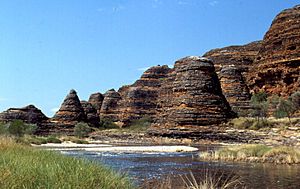Bungle Bungle Range facts for kids
The Bungle Bungle Range is an amazing natural wonder in Western Australia. It's a huge part of the Purnululu National Park. You can find it in the Kimberley area. This range is famous for its unique, beehive-shaped rock towers.
Contents
How the Bungle Bungles Formed
The Bungle Bungle Range looks like giant beehives! These unique towers are made from two types of rock: sandstone and conglomerate. Conglomerate is a rock made of pebbles and boulders stuck together.
These rocks were laid down in a place called the Red Basin. This happened about 375 to 350 million years ago. At that time, the land was changing a lot due to active faults.
Over millions of years, strong winds from the Tanami Desert and heavy rainfall slowly shaped these rocks. This natural process carved out the amazing dome shapes we see today.
What the Bungle Bungles Look Like
The Bungle Bungle Range sits on the flat lands at the edge of the eastern Kimberley region. The range is made of old seabeds stacked on top of each other. These layers also contain a rock called dolomite.
If you look at satellite images, you can see a large circular shape. It's about 7 kilometres (4.3 miles) wide. Scientists think this is what's left of a very old meteorite impact crater. It's known as the Piccaninny crater.
The Amazing Colors of the Rocks
The rocks have unusual orange and dark grey stripes. These stripes are caused by different layers of sandstone. The darker bands are where the rock holds more moisture. This allows a dark growth of algae or cyanobacteria to form.
The bright orange layers get their color from iron and manganese minerals. These minerals are found within the sandstone. They stain the rock, giving it its distinctive orange glow.
The Bungle Bungle Range covers a large area. It stretches across about 450 square kilometres (170 square miles).
History of the Bungle Bungles
The traditional owners of this land are the Karjaganujaru peoples. They have lived in this area for over 20,000 years. They still have a strong connection to this ancient landscape.
The Purnululu National Park is managed by the Western Australian Department of Environment and Conservation. They work together with the traditional Aboriginal owners.
For a long time, only local Aboriginal people and stockmen knew about the range. Then, in 1982, filmmakers made a documentary about the Kimberley region. This film helped to make the Bungle Bungles famous.
The area officially became a National Park in 1987. In 2003, it was also named a World Heritage Site. This means it's recognized as a very important natural place for the whole world.
Images for kids





